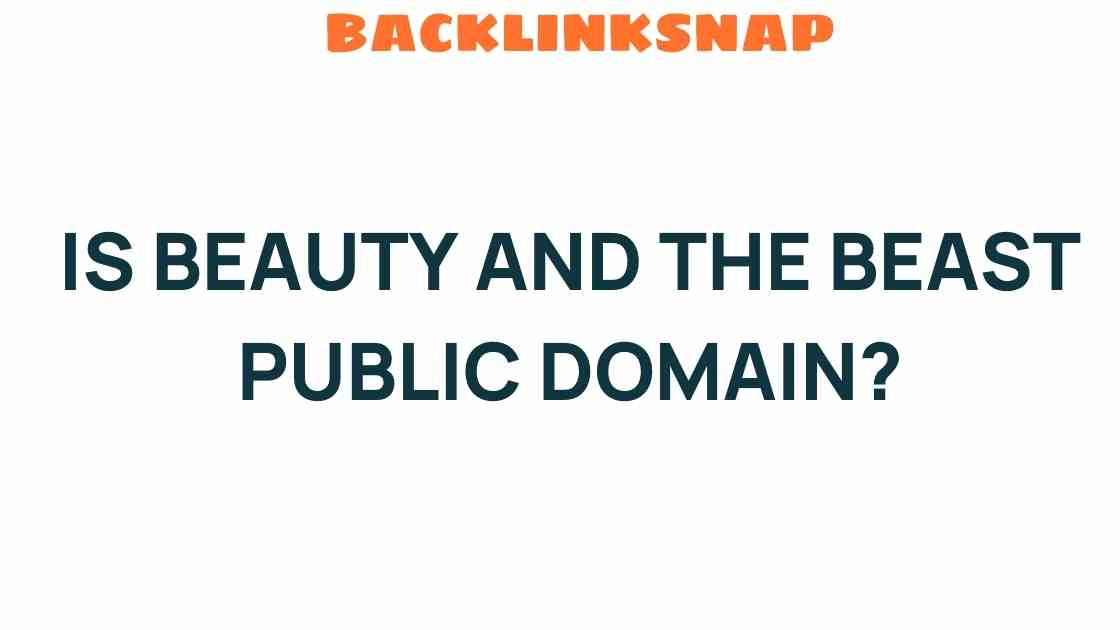Is “Beauty and the Beast” Public Domain? Unraveling the Fairy Tale’s Legal Status
The enchanting tale of “Beauty and the Beast” has captivated audiences for centuries, embodying themes of love, transformation, and redemption. Yet, amidst its timeless charm, there’s an important question that often arises: Is “Beauty and the Beast” public domain? Understanding its legal status is crucial, especially in an era where adaptations and reinterpretations abound. In this article, we’ll delve into the origins of the fairy tale, explore its copyright status, and examine the implications for adaptations, particularly in the context of Disney’s famous rendition.
The Origins of “Beauty and the Beast”
The story of “Beauty and the Beast” traces back to various folklore traditions, with the most notable version penned by French novelist Gabrielle-Suzanne Barbot de Villeneuve in 1740. However, it was the 1756 abridged version by Jeanne-Marie Leprince de Beaumont that popularized the tale, making it accessible to a wider audience. This version focuses on the moral lessons of kindness and inner beauty, themes that resonate deeply in contemporary culture.
Folklore studies reveal that tales similar to “Beauty and the Beast” exist in various cultures, emphasizing the universal nature of its themes. The tale has been told in countless forms, from oral stories to theatrical adaptations, highlighting its enduring appeal.
Understanding Public Domain and Copyright
To determine whether “Beauty and the Beast” is public domain, one must first understand the concepts of copyright and public domain. Copyright is a legal framework that grants creators exclusive rights to their works, such as literature, music, and art. These rights typically last for a specific period, after which the work enters the public domain, meaning it is free for anyone to use without permission.
Under current U.S. copyright law, any work published before 1923 is considered public domain. Since the most recognized versions of “Beauty and the Beast” were published in the 18th century, they fall well within this category. Consequently, both de Villeneuve’s and Beaumont’s versions of the tale are now public domain, allowing for free adaptation and reinterpretation.
The Impact of Public Domain on Adaptations
The public domain status of “Beauty and the Beast” has led to a plethora of adaptations across various media. From stage productions to films, and even ballets, creators have drawn inspiration from this classic fairy tale. Disney’s animated film, released in 1991, is perhaps the most iconic adaptation, introducing the story to a new generation and solidifying its place in popular culture.
This adaptation, however, is not without its complications. While the original story is public domain, Disney’s specific portrayal—including character designs, plot elements, and music—remains under copyright protection. This highlights an important aspect of intellectual property: while the base story can be freely adapted, unique artistic interpretations cannot. Thus, while you can create your own version of “Beauty and the Beast,” you must be careful not to infringe on Disney’s rights.
Literary Analysis of “Beauty and the Beast”
Engaging with “Beauty and the Beast” from a literary perspective reveals deeper themes that resonate across generations. At its core, the tale explores the nature of love, emphasizing that true beauty lies within. This notion challenges societal norms and encourages readers to look beyond surface appearances.
Additionally, the character of the Beast serves as a symbol of transformation. His journey from a cursed prince to a loving partner underscores the idea that redemption is possible through love and understanding. Through this lens, “Beauty and the Beast” becomes not just a story about romance but also a narrative about personal growth and societal acceptance.
Frequently Asked Questions
- Is “Beauty and the Beast” in the public domain?
Yes, the original versions by de Villeneuve and de Beaumont are in the public domain, allowing free adaptations.
- Can I adapt “Beauty and the Beast” without permission?
You can adapt the original story, but ensure your adaptation does not infringe on any copyrighted elements from existing adaptations, such as Disney’s.
- What is the significance of the public domain in literature?
The public domain allows for creative freedom and encourages new interpretations of classic works, enriching cultural discourse.
- Are there modern adaptations of “Beauty and the Beast”?
Yes, many adaptations exist, including films, stage productions, and even retellings in novels that explore contemporary themes.
- How does Disney’s adaptation differ from the original tale?
Disney’s version includes musical elements, a more developed romantic plot, and characters with distinct personalities that differ from the original narrations.
- What are the moral lessons in “Beauty and the Beast”?
The tale emphasizes the importance of looking beyond appearances, valuing inner beauty, and the transformative power of love.
Conclusion
In summary, “Beauty and the Beast” is indeed in the public domain, thanks to its historic origins and the expiration of copyright on its earlier versions. This status opens a world of creative possibilities for artists and storytellers, allowing them to explore and reinterpret the themes of this beloved fairy tale. Whether through literature, film, or other media, the story continues to resonate, reminding us of the enduring power of love and the beauty found within.
As we reflect on the tale’s legacy, it’s clear that “Beauty and the Beast” will remain a significant part of our cultural fabric, inspiring new generations to create and share their interpretations. For those interested in further exploring the complexities of copyright and public domain literature, resources like the U.S. Copyright Office provide valuable information.
With the ongoing interest in fairy tales and their adaptations, it’s an exciting time for creators and audiences alike. So, whether you’re planning to write your own version or simply enjoy the multitude of adaptations available, “Beauty and the Beast” continues to be a treasure trove of inspiration.
For more insights on adaptations and copyright, feel free to check out our article on intellectual property laws and their impact on creative works.
This article is in the category Digital Marketing and created by BacklinkSnap Team




